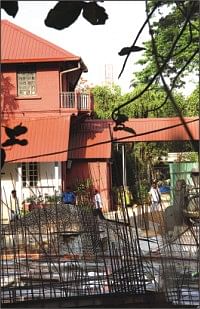A scar on the charming Chummery House

A new structure is being built just on the face of Chummery House.Photo: Syed Zakir Hossain
While conservationists decry construction of a 6-storey building on the premises of century-old Chummery House at the city's Topkhana Road labelling the act as ruinous for the magnificent architecture, the government goes on with the work.
Such a tall structure on the premises of Chummery House will spoil the heritage building's aesthetic beauty, said architects and historians.
Chummery House, popularly known as Chameli House, is an integral feature of a unique township set up during the British era, said noted historian Prof Muntasir Mamoon, who has extensively worked on Dhaka's history.
“Chummery House is witness to many historic events,” said Mamoon.
Destroying surroundings of the beautiful house mutilating its original view is unacceptable, he said adding that frontal view and entire area of Chummery House must remain intact and unspoiled.
Chummery House used to be the residence of bachelor British high officials. In 1938, it was used as the girl students' dormitory of Dhaka University, according to Mamoon.
During the Pakistan rule and after the country's independence, the building used to be either as government office or residential quarters.
The building was handed over to the Centre for Integrated Rural Development for Asia and Pacific (Cirdap) in the mid 1970s to run its office.
The Public Works Department (PWD) is constructing the 6-storey building for Cirdap which will hold a conference of the Cirdap member countries there in 2009.
Sub-divisional Engineer of PWD Zillur Rahman said his department will construct three floors of the building in the first phase with a Tk 10-crore fund from the Bangladesh government. The first phase structure includes two conference halls.
The new structure will be built in a way that it will not spoil the original building or its frontal garden, Zillur said. “It will not obstruct the view of Chummery House.”
However, sources concerned said certain original features of Chummery House have already been altered and distorted in the name of renovation by the government.
A top official at the public works ministry admitted that many original features of the building's interior and exterior have been altered and spoilt at different times.
Originally, Chummery House had a see-through boundary wall, which was turned into a solid concrete wall at the behest of the LGRD ministry on demand from Cirdap, he said.
“The present solid wall was built in 2001 beyond knowledge of the Department of Architecture,” the official said requesting anonymity.
The roof of Chummery House, made of red slats, was renovated in 2006 replacing the original building materials with new stuffs. A two-storey building with a conference hall was built in 1995 at the back of the original structure.
An environmentalist group, Save the Environment Movement, organised a press conference in the city on April 2 on the issue.
Kamal Lohani, a veteran journalist and convenor of the Heritage Conservation Committee of Save the Environment Movement, said the original red tiled roof of the house has been replaced spoiling its originality and aesthetic look.
“It is an architectural relic and a mark of past history with a distinct architectural style that we must conserve for our cultural identity,” said Lohani.
“It is not understandable why the government is hell-bent on erecting a new structure on the premises of an old building with distinct architecture.”
Chairman of the movement, Abu Naser Khan, said the old building must be kept in its original layout with open lawn and backyard.
According to Prof Muntasir Mamoon, Chummery House, Curzon Hall, Governor House (Old High Court building), the foreign ministry office and the Ramna Green would together constitute a magnificent and charming landscape.
The entire area was elegantly planned as an urban settlement in the Ramna Green at the heart of Dhaka as the new capital of East Bengal and Assam following division of British Bengal in 1905 known as Bangabhanga, he said.
British architect Robert Luis Proudolk designed the layout of the area and some buildings there, said a leading architect.
“It is an example of beautiful town planning,” said Mamoon. “We are losing these historical and architectural treasures one after another. The government could have built a new building anywhere else to save the unique entity of this historic house.”
Architect Iqbal Habib, member secretary of environmentalist group Bangladesh Paribesh Andolon, said that the Building Construction rules of 2006 require all to show respect for conservation of any historic and heritage buildings.
“But the government authorities, particularly the Department of Architecture, appear insensitive and irresponsive to a heritage building like Chummery House,” he said.
ASM Ismail, chief architect of the Department of Architecture, said in consideration of the reality of a land-starved country, it is difficult to keep this amount of space unused.
“We have consciously blended the motifs and architectural elements of the old building in the design of the new one,” he said. “Architectural features of the new building will be consistent with those of the old one.”
He said the authorities will not spoil the existing garden in front of the building. “Not a single tree has been felled on the premises,” he said.
Ismail mentioned that two tin-shed structures were built on the premises of Chummery House in 1972 and they have been there for more than three decades. Later, a two-storey building was constructed replacing one of the tin-sheds.
Now the government is constructing the six-storey building at the place of the other tin-shed structure.
Ismail agreed that heritage buildings should be conserved but cited examples of Louvre Museum in Paris, Tate Gallery in London and Museum of Modern Art in New York, saying that extensions took place on those age-old heritage building premises too.

 For all latest news, follow The Daily Star's Google News channel.
For all latest news, follow The Daily Star's Google News channel. 



Comments